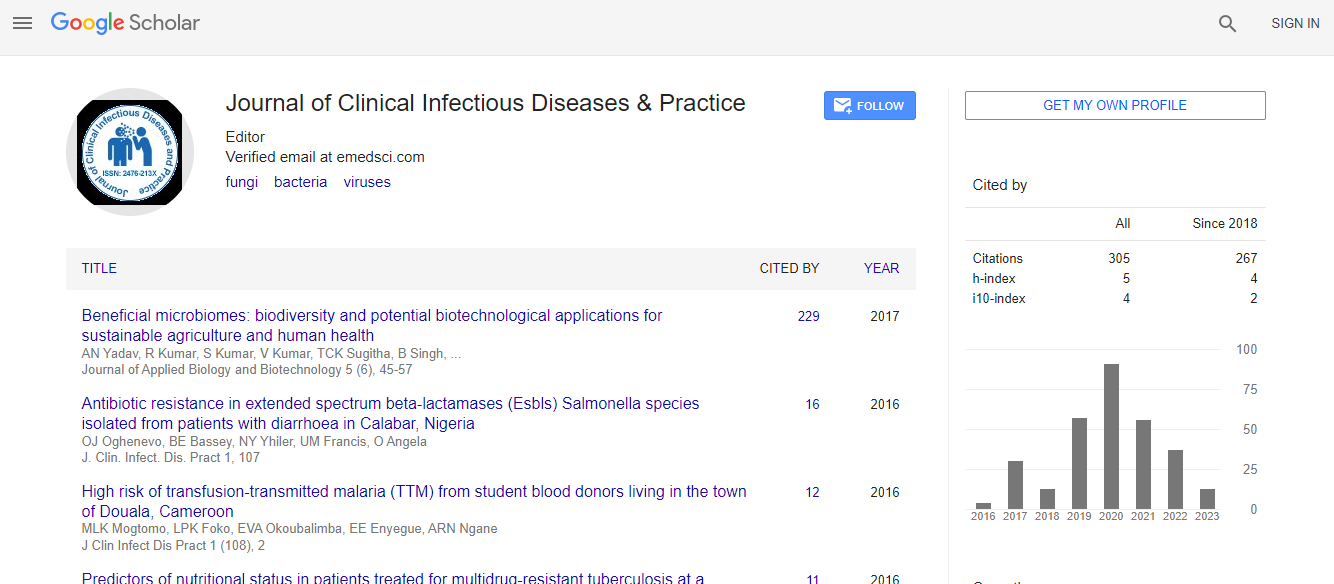Research Article
Antibiotic Resistance in Extended Spectrum Beta-Lactamases (Esbls) Salmonella Species Isolated from Patients with Diarrhoea in Calabar, Nigeria
Odafe James Oghenevo1, Bassey Enya Bassey1,2*, Nchawa Yangkam Yhiler1, Useh Monday Francis1 and Okocha-Ejeko Angela2
1Department of Medical Laboratory Science, Faculty of Allied Medical Science, University of Calabar, Calabar, Nigeria
2World Health Organization, UN HOUSE, Plot 617/618, Central Area District, FCT, Abuja, Nigeria
- *Corresponding Author:
- Bassey Enya Bassey
Department of Medical Laboratory Science
Faculty of Allied Medical Science
University of Calabar, Calabar, Nigeria
Email: yankgam@yahoo.com
Received Date: June 27, 2016; Accepted Date: July 16, 2016; Published Date: July 20, 2016
Citation: Oghenevo O, Bassey B, Yhiler N, Francis U, Angela O (2016) Antibiotic Resistance in Extended Spectrum Beta-Lactamases (Esbls) Salmonella Species Isolated from Patients with Diarrhoea in Calabar, Nigeria. J Clin Infect Dis Pract 1:107. doi: 10.4172/2476-213X.1000107
Copyright: © 2016 Bassey BE, et al. This is an open-access article distributed under the terms of the Creative Commons Attribution License, which permits unrestricted use, distribution, and reproduction in any medium, provided the original author and source are credited.
Abstract
Objective: This study seeks to evaluate the prevalence of Salmonella producing ESBLs strains by phenotypic methods and their profile of drug resistance amongst patients with diarrhoea due to gastroenteritis and enteric Fever in Calabar, Nigeria.
Methods: Stool samples were collected from 256 patients in Calabar with diarrhoea due to enteric fever and gastroenteritis. They were examined for Salmonella infection. Isolation and detection of Salmonella species was done following the standard ISO 6579:2002/Amd2007 method. Modified double disc synergy and phenotypic confirmatory tests were used to determine ESBL-producing Salmonella species.
Results: Salmonella isolates were recovered from 44 (17.2%) stool samples; 24 (9.4%) were ESBLs producers and 20 (7.8%) were non-ESBLs producers. Eight (33.3%) and 3 (15.0%) strains of both ESBL producing and nonESBL producing respectively, demonstrated resistance against 7 of the 8 antibiotics used in this study. Resistance against 3rd generation cephalosporin was observed in 34 (77.3%) of the Salmonella strains against ceftazidime, 26 (59.1%) against cefotaxime while all 44 (100%) Salmonella strains were resistant against ceftriaxone.
Conclusion: The presence of ESBL Salmonella amongst isolated strains should not be overlooked. We recommend continuous surveillance of antimicrobial resistant strains and the rational use antimicrobials agents

 Spanish
Spanish  Chinese
Chinese  Russian
Russian  German
German  French
French  Japanese
Japanese  Portuguese
Portuguese  Hindi
Hindi 
